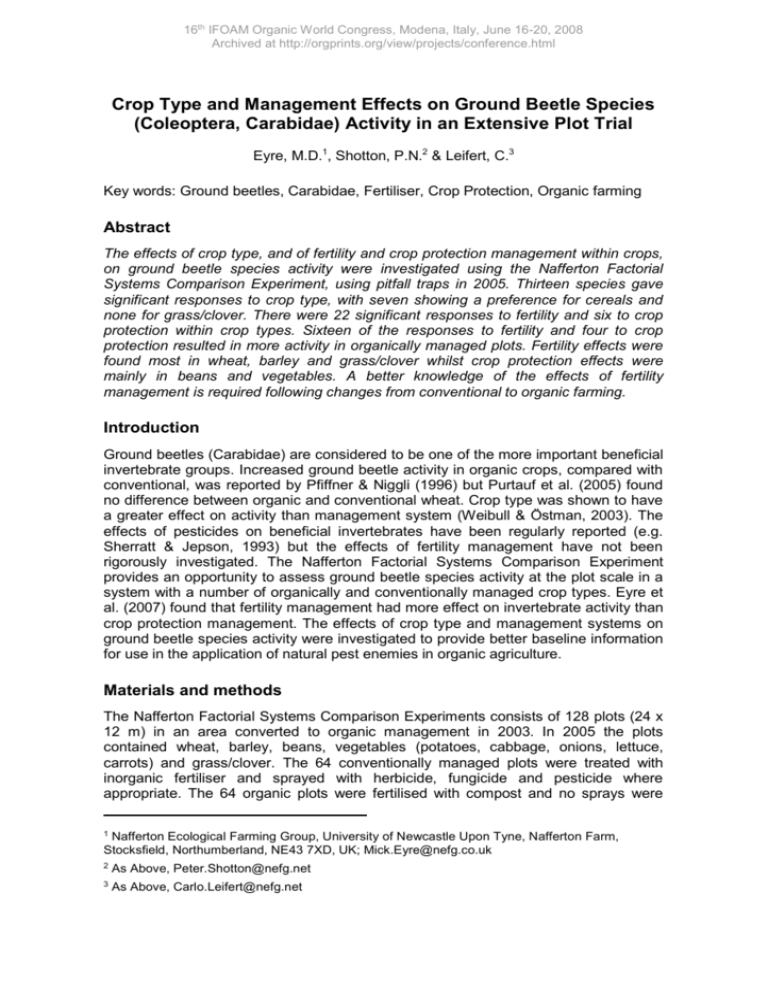Crop Type and Management Effects on Ground Beetle Species
advertisement

16th IFOAM Organic World Congress, Modena, Italy, June 16-20, 2008 Archived at http://orgprints.org/view/projects/conference.html Crop Type and Management Effects on Ground Beetle Species (Coleoptera, Carabidae) Activity in an Extensive Plot Trial Eyre, M.D.1, Shotton, P.N.2 & Leifert, C.3 Key words: Ground beetles, Carabidae, Fertiliser, Crop Protection, Organic farming Abstract The effects of crop type, and of fertility and crop protection management within crops, on ground beetle species activity were investigated using the Nafferton Factorial Systems Comparison Experiment, using pitfall traps in 2005. Thirteen species gave significant responses to crop type, with seven showing a preference for cereals and none for grass/clover. There were 22 significant responses to fertility and six to crop protection within crop types. Sixteen of the responses to fertility and four to crop protection resulted in more activity in organically managed plots. Fertility effects were found most in wheat, barley and grass/clover whilst crop protection effects were mainly in beans and vegetables. A better knowledge of the effects of fertility management is required following changes from conventional to organic farming. Introduction Ground beetles (Carabidae) are considered to be one of the more important beneficial invertebrate groups. Increased ground beetle activity in organic crops, compared with conventional, was reported by Pfiffner & Niggli (1996) but Purtauf et al. (2005) found no difference between organic and conventional wheat. Crop type was shown to have a greater effect on activity than management system (Weibull & Östman, 2003). The effects of pesticides on beneficial invertebrates have been regularly reported (e.g. Sherratt & Jepson, 1993) but the effects of fertility management have not been rigorously investigated. The Nafferton Factorial Systems Comparison Experiment provides an opportunity to assess ground beetle species activity at the plot scale in a system with a number of organically and conventionally managed crop types. Eyre et al. (2007) found that fertility management had more effect on invertebrate activity than crop protection management. The effects of crop type and management systems on ground beetle species activity were investigated to provide better baseline information for use in the application of natural pest enemies in organic agriculture. Materials and methods The Nafferton Factorial Systems Comparison Experiments consists of 128 plots (24 x 12 m) in an area converted to organic management in 2003. In 2005 the plots contained wheat, barley, beans, vegetables (potatoes, cabbage, onions, lettuce, carrots) and grass/clover. The 64 conventionally managed plots were treated with inorganic fertiliser and sprayed with herbicide, fungicide and pesticide where appropriate. The 64 organic plots were fertilised with compost and no sprays were 1 Nafferton Ecological Farming Group, University of Newcastle Upon Tyne, Nafferton Farm, Stocksfield, Northumberland, NE43 7XD, UK; Mick.Eyre@nefg.co.uk 2 As Above, Peter.Shotton@nefg.net 3 As Above, Carlo.Leifert@nefg.net 16th IFOAM Organic World Congress, Modena, Italy, June 16-20, 2008 Archived at http://orgprints.org/view/projects/conference.html used. Each plot was sampled for epigeic invertebrates using five pitfall traps with saturated salt solution and a small amount of detergent as a preservative, were set in the first week of May 2005 and five monthly samples were generated (see Eyre et al., 2007). Samples were sorted in the laboratory and ground beetles identified to species. The number of individuals of 30 of the 53 species recorded, transformed by log 10n+1, was used in linear mixed-effects models in the R statistical environment (R Development Core Team, 2007). Analysis of variance was generated using models with fertility, crop protection and crop as fixed factors and the blocks of the trial as a random factor. Data from all plots were used to assess the effect of crop type whilst the effects of differing fertility and crop protection management were assessed within each crop type. Results There were highly significant relationships between crop type and the activity of 13 ground beetle species (Tab. 1). Five species were most active in wheat, four in beans, two each in barley and vegetables and none in grass/clover. Five species had the least activity in the vegetable and grass/clover plots, two in beans and one in barley. Significant responses of ground beetle species activity to organic or conventional fertility or crop management in each of the crops are shown in Tab. 2, with plot means showing the preference for management type. Four species gave significant responses to fertility in grass/clover, three preferring organic and one conventional management. One species preferred conventional fertility in beans with the activity of three significantly related to crop protection, two preferring conventional plots. Eight species were affected significantly by fertility in wheat, with more of six in organic plots. One species was more active in organic crop protection wheat plots whilst all eight species giving significant responses in barley were affected by fertility, six more active in organic plots. Only one species preferred organically fertilised vegetable plots whilst two were more active in vegetable plots with organic crop protection. Tab. 1: Ground beetle species giving a significant response to crop type and the mean number recorded from plots in the five crop types. Species Amara familiaris Amara plebeja Anchomenus dorsalis Bembidion aeneum Bembidion guttula Bembidion lampros Bembidion tetracolum Loricera pilicornis Nebria brevicollis Notiophilus biguttatus Pterostichus melanarius Pterostichus strenuus Trechus quadristriatus *** significant for P<0.001 Grass/ clover 3 6 5 35 9 12 12 20 35 4 51 13 26 Beans Wheat Barley Vegetables 7 6 7 23 31 36 49 20 74 5 37 10 31 1 10 5 54 22 12 8 19 132 6 89 11 146 2 13 3 47 12 13 6 31 107 6 71 24 92 1 3 2 25 10 55 31 3 122 7 41 4 44 *** *** *** *** *** *** *** *** *** *** *** *** *** 16th IFOAM Organic World Congress, Modena, Italy, June 16-20, 2008 Archived at http://orgprints.org/view/projects/conference.html Tab. 2: Ground beetle species giving a significant response to either fertility or crop protection within each crop type, together with mean numbers recorded from plots with organic and conventional management. Crop and species Grass/clover Amara plebeja Nebria brevicollis Pterostichus melanarius Trechus quadristriatus Beans Amara familiaris Bembidion lampros Bembidion quadrimaculatum Trechus quadristriatus Wheat Bembidion guttula Bembidion lampros Bembidion tetracolum Loricera pilicornis Nebria brevicollis Notiophilus biguttatus Pterostichus melanarius Pterostichus strenuus Synuchus vivalis Barley Agonum muelleri Bembidion aeneum Bembidion lampros Bembidion tetracolum Loricera pilicornis Nebria brevicollis Pterostichus melanarius Pterostichus strenuus Vegetables Bembidion aeneum Bembidion tetracolum Pterostichus strenuus * significant for P<0.05 ** significant for P<0.01 *** significant for P<0.001 Factor Organic Conventional Fertility Fertility Fertility Fertility 8 48 65 19 4 21 37 34 * *** ** *** Fertility Crop protection Crop protection Crop protection 5 29 1 26 9 44 4 38 * * * * Fertility Fertility Fertility Fertility Fertility Fertility Fertility Crop protection Fertility 30 17 13 11 166 4 126 13 7 14 7 4 26 97 7 53 10 2 ** ** ** ** *** * ** * *** Fertility Fertility Fertility Fertility Fertility Fertility Fertility Fertility 9 36 17 9 19 147 96 17 1 59 9 2 43 67 45 32 *** * * ** *** *** *** ** Crop protection Crop protection Fertility 29 48 6 22 15 2 * *** * 16th IFOAM Organic World Congress, Modena, Italy, June 16-20, 2008 Archived at http://orgprints.org/view/projects/conference.html Discussion Of the 13 ground beetle species providing significant responses to crop type, nine were most active in the tall wheat and beans whilst none were most active in grass/clover. Grass/clover provided the densest ground cover and it appears that all 13 species preferred some bare ground, with the smaller species most active in crops with the least ground cover. Eyre (2006) showed that ground beetle species differ in their reaction to disturbance and the less ground cover, the more disturbed and exposed the plot and Kromp (1999) postulated that inorganic fertiliser may have an effect on ground beetle activity in crops. Within crop types, fertility management had considerably more effect on species activity than crop protection management, especially in cereals. There was a marked preference for organically fertilised plots in wheat, barley and grass/clover. The two species with a preference for conventionally managed bean may have reacted to more bare soil and fewer weeds given the herbicide application. Conclusions The results indicate that far more attention needs to be given to the effects of fertility management on invertebrate activity and distribution in crops. This will have an effect on the efficient use of beneficial invertebrates in pest control within organic agriculture. Acknowledgments The authors gratefully acknowledge funding from the European Community financial participation under the Sixth Framework Programme for Research, Technological Development and Demonstration Activities for the Integrated Project QUALITYLOWINPUTFOOD, FP6-FOOD-CT-2003- 506358. References Eyre, M.D. (2006): A strategic interpretation of beetle (Coleoptera) assemblages, biotopes, habitats and distribution, and the conservation implications. J. Insect Cons. 10: 151-160. Eyre, M.D., Volakakis, N., Shotton, P.N., Leifert, C. (2007): The effects of crop type and production systems on the activity of beneficial invertebrates. In Niggli, U., Leifert, C., Alföldi, T., Lück, L., Willer, H. (eds): Improving Sustainability in Organic and Low Input Food Production Systems. Research Institute of Organic Farming FiBL, Frick, Switzerland, p 193-196. Kromp, B. (1999): Carabid beetles in sustainable agriculture: a review on pest control efficacy, cultivation impacts and enhancement. Agric. Ecosys. & Environ. 74: 187-228. Pfiffner, L., Niggli, U. (1996): Effects of bio-dynamic, organic and conventional farming on ground beetles (Col Carabidae) and other epigaeic arthropods in winter wheat. Biol. Agric. Hortic. 12: 353-364. Purtauf, T., Roschewitz, I., Dauber, J., Thies, C., Tscharntke, T., Wolters, V. (2005) Landscape context of organic and conventional farms: Influences on carabid beetle diversity. Agric. Ecosyst. & Environ. 108: 165-174. R Development Core Team (2007): R: A language and environment for statistical computing. R Foundation for Statistical Computing, Vienna, Austria. Sherratt, T.N., Jepson, P.C. (1993): A metapopulation approach to modelling the long-term effects of pesticides on invertebrates. J. Appl. Ecol. 30: 696-705. Weibull, A.C., Östman, O. (2003): Species composition in agroecosystems: The effect of landscape, habitat, and farm management. Basic Appl. Ecol. 4: 349-361.







